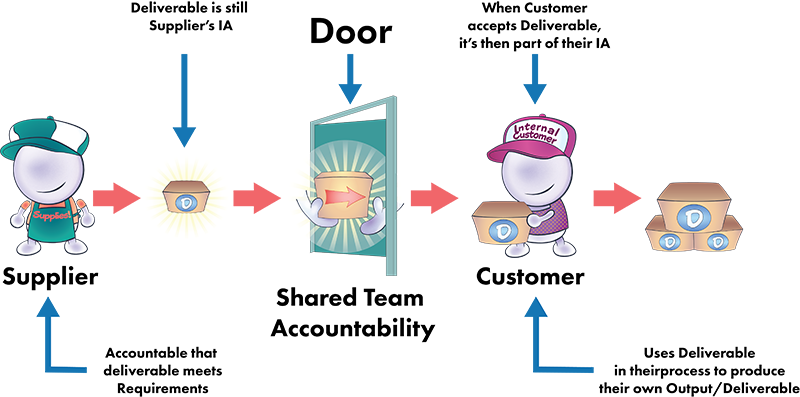- 2Q1. Customer and supplier accountability
- 2Q1i. The supplier has individual accountability to produce the deliverables needed by the customer, based on the agreed upon requirements. Once the customer (or the internal customer representative or customer rep) accepts the output from the supplier, the output becomes a part of the customer’s process and is no longer the accountability of the supplier.
- 2Q1ii. It’s as if there is a door separating the supplier and the customer, and when the customer opens the door and accepts the input, the door closes again with the input inside the customer’s domain and is now part of his accountability.
- 2Q1iia. Figure 2.16. The door into the customer’s “domain”.

- 2Q1iia. Figure 2.16. The door into the customer’s “domain”.
- 2Q1iii. The customer, as a supplier to the next step in the process, has an accountability to deliver a deliverable to his own customer(s). He is dependent on his suppliers to provide the inputs he needs in order to do that. Therefore, he must negotiate with the supplier for what he needs (his deliverable requirements) so he can successfully produce his own deliverables. This dependence of the customer on the supplier forces the two parties to work together.
- 2Q1iv. The supplier may accept or not accept the accountability requested by the customer.
- 2Q1v. Every deliverable must be produced according to the specified deliverable requirements.
- 2Q1va. The accountability of the supplier is based on the deliverable requirements. For business processes, these requirements are usually defined when the process is designed; therefore, they already exist. This is not usually the case with projects, because projects, by definition, produce unique deliverables and therefore the requirements for the final deliverable of the project must be defined before work can begin on the project.
- 2Q1vb. It’s also sometimes necessary to define the requirements for interim deliverables: those deliverables produced within a process.
- 2Q1vc. Defining the requirements of a deliverable is also referred to as defining scope and is done in cooperation with the customer of the deliverable. If the customer is external, and cannot participate in a deliverable requirement process, there needs to be someone internally, a customer rep, who can speak for the external customer and negotiate the requirements.
- 2Q2. If the customer and supplier are on the same team, they share team accountability for the final deliverable of the team. Therefore:
- 2Q2i. Both parties need to cooperate to make sure they are both successful.
- 2Q2ii. The relationship between the customer and supplier should be a partnership. If they are both on the same team and share team accountability for the same outcome, they must act as partners.
- 2Q2iia. In a true partnership, the two parties are equal and work towards win-win solutions.
- 2Q2iib. In a dysfunctional “partnership,” the parties are not equal, with one party dominating the relationship.
- 2Q2iii. The supplier must meet the customer’s needs, which need to be the basis for the deliverable requirements.
- 2Q2iiia. Needs include: the problem the deliverable will solve or the opportunity the customer wants to take advantage of. Needs are the features and functions that fall into the “must have” category. Needs must be matched with available resources and must be technically feasible.
- 2Q2iiib. Requirements are the list of features and functions that are technically feasible, that can be resourced, and that the customer and supplier agree will be included in the deliverable, to be produced by the individual who accepts accountability for the deliverable.
- 2Q2iiic. A supplier typically does not satisfy all the customer’s wants. Wants include specific features and functions that the customer would like to have included in the deliverable. Not all wants can necessarily be accommodated because of limitations of resources or technical obstacles.
- 2Q3. Stakeholder accountability
- 2Q3i. Stakeholders are anyone who is affected by the team or who can affect the team.
- 2Q3ii. Internal stakeholders:
- 2Q3iia. Key internal stakeholders, such as the customers and key suppliers, are usually included on the team and therefore share team accountability for the team’s outcomes.
- 2Q3iib. Other stakeholders who are not on the team share organizational accountability to act in the best interests of the organization, which means supporting any selected and prioritized team efforts.
- 2Q3iii. External stakeholders:
- 2Q3iiia. External stakeholders have no accountability to the team since they are not a part of the organization. They may, however, have a contractual agreement with the organization.
- 2Q3iiib. Key external stakeholders should have a team member liaison. That person acts as the representative for the external stakeholder.
